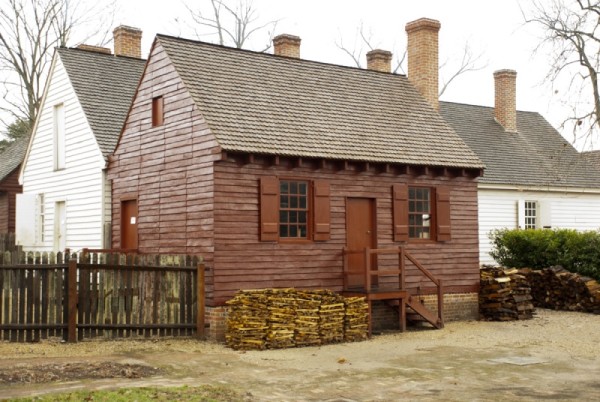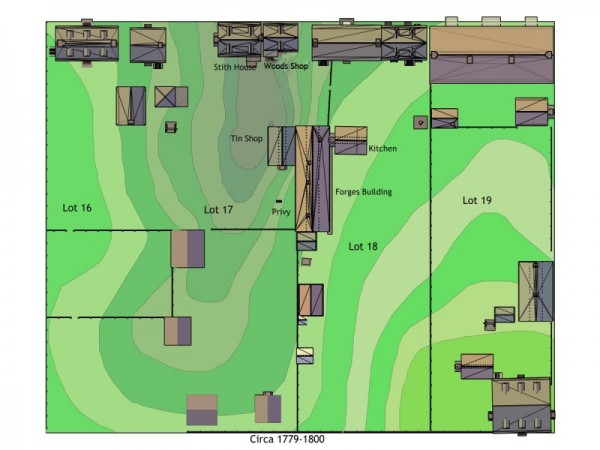In 1932 Colonial Williamsburg architects uncovered the brick foundations of a 16 by 24-foot building on colonial lot 17, next door to James Anderson’s
Figure 1. 1932 excvavation of the “tin shop”.
Publick Armoury (Figure 1). A reference made to this building in an early 19th century will identified it as the Armoury’s “tin shop,” and so it has been identified, beyond its destruction in 1842 and through two subsequent Colonial Williamsburg reconstructions in 1940 and 2012 (above).
In spite of the durability of the name, this building served as the tinsmith’s shop for only a short period between 1778 and 1780. For most of its existence, it was a domestic structure, the home of free African American citizens of Williamsburg. Although recent archaeology has shown that the little building was likely constructed in the late 1760s, we know more about its role as a free black residence in the first half of the nineteenth century, largely because of a remarkable woman named Mary Stith.
The town’s historical records show that Stith, daughter of William and Mary’s third president, William Stith, bought lot 17 and its three houses in 1785, just after the war. At the time, she owned six slaves, but by the turn of the century, she had manumitted (freed) them all. Regardless of their new status, they seemed to have stayed with their former mistress, living in the three houses on her lot. In 1813, Mary Stith drew up her will, leaving her property and her fortune to her “family”:
“All the coloured people in my family being born my slaves, but now liberated, I think it my duty not to leave them destitute nor to leave them unrecompensed for past services rendered to me. As in the cause of humanity I can do but little for so many, and that little my conscience requires me to do, therefor I subject the whole of my estate to the payment of my just debts, and to the provision which I herein make for them.[1]“
She left her house to Jenny “the mother”, an adjacent building called “the Woods Shop” to Nelly, Eve and Sally Bolling and the “house in my yard called the tin shop” to Jane and Patty Gillett (image above.). From the Register of Free Negroes, we even know what the sisters looked like:
Jane was…a bright mulatto abt. 22 or 23 years of age 5 feet 1 ½ Inches high has a scar on her left arm[,] black Eyes[,] Ear[s] perforated for Earrings[,] small regular features & good countenance[.]
Born in 1794, Patty alias Martha Gillett is a short black woman abt. 21 years of age 5 feet 1 ¼ Inches high[,] long hair, which she usually wears platted before - flat nose, on the left side of wch. is a scar — & one on left side of her chin.[2]
Archaeology in 2010 and 2011 associated with the Armoury Reconstruction Project, revealed more and more about the Gillett sisters through the artifacts they left behind and the excavation of their privy. The analysis of fragments of plates and dishes that likely belonged to the sisters includes pottery types manufactured throughout a long period during the eighteenth century. From this we can interpret that many of the tablewares the Gilletts were using were of fine quality but no longer fashionable. A small number of newer, nineteenth-century stoneware and whiteware (ironstone) vessel fragments show they were able to acquire some “modern” ceramics as well. Were these hand-me-downs from Mary Stith and/or gifts or payments for work they did in the home or outside? Unfortunately, neither the archaeology nor the written records have provided any clues to their source of livelihood after Mary Stith’s death in 1815.
Analysis of their privy fill shows that like most people of the period, black and white, the sisters suffered mildly from the common intestinal parasites roundworm (Ascaris) and whipworm (Trichurus). The number of parasite egg casings recovered fortunately suggests a light infestation. In cases of heavy infection, the liver and spleen can be compromised, resulting in extreme abdominal discomfort[3].
Jane and Martha lived in the so-called “tin shop” for nearly 30 years, before it was destroyed by the 1842 fire that consumed almost the entire block. Although they belonged to a slightly later period than the Revolutionary City, and for that reason aren’t included in the interpretation of the Publick Armoury, it is essential for us to remember the vital role that they and the thousands of other people of African descent, both free and enslaved, played in shaping the history of our town.
Andrew Edwards, Staff Archaeologist
[1] Robert Anderson Account books, Williamsburg and Yorktown, 1800-1854. Rockefeller Library Micofilm #M82-2. Original Virginia Historical Society, Richmond.
[2] Register of Free Negroes, 1811.
[3] Jacobucci, Susan and Heather Trigg, “A Parasitological of a sample from Feature 10, the Armoury Site, Virginia” 2011. Report submitted to the Colonial Williamsburg Foundation.



Leave a Reply